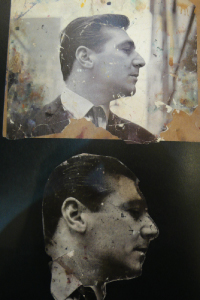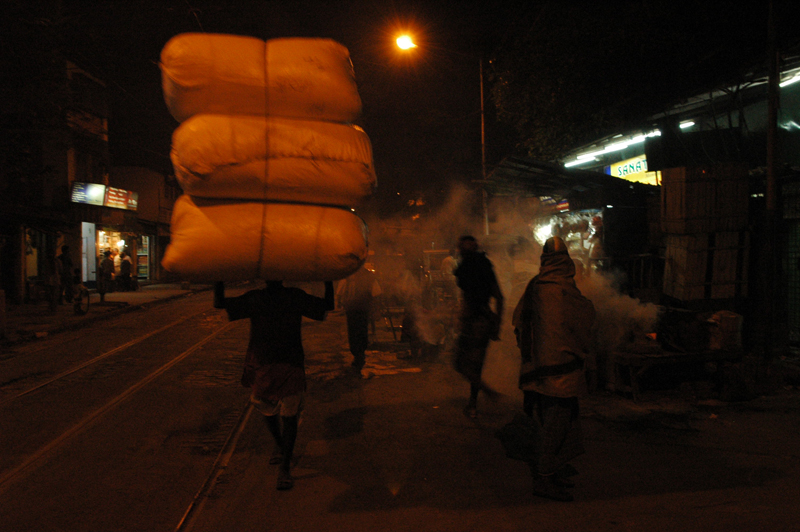| So where does painting start and photography end? |
 |
| Written by Pedro Meyer |
|
In the picture above we are in front of a painting that was presented at the Shanghai Biennial of Art in 2006. The painting is based on the perceptions associated with photography, to the extent that the men depicted in the painting appear in a pose usually associated with portrait photography. If we have any doubts about that, just behind these three Chinese gentlemen, you will find another painting depicting a man in the process of taking a photograph of precisely those same three men in the foreground of the painting. Now mind you, you are in fact looking at all of this through a photograph which is the one that is looking at the overall painting. We have the back and forth echoes between photography and painting that is the subject of this editorial.
A lot of modern art is based upon the use of photography as a reference. Quoting Francis Bacon: “One thing which has never been really worked out is how photography has completely altered figurative painting.”
It has been clear for quite some time now, however, that photography has in fact influenced painting. And yet, it remains unclear how painting has been influencing photography in later days. Nevertheless, that has started to change with the appearance of digital tools that allow photographers the same creative freedom with the image that has been so prevalent in painting.
Below is a photograph I took in India, and then transformed in a painterly manner, with Corels’ Painter program. I have been asked many times why do I choose to manipulate the image so that it is neither a straight photograph and nor is it really a painting in the sense of how the materials are being used.
What we are dealing with here is really something different and new, which has yet to be fully understood as to technical and artistic implications. I already discussed some of these ideas in Editorial No. 68 of November 2006. Which I would encourage you to revisit.
2006 © Pedro Meyer Click image on hot spots to see detail.
I believe we have entered a new era where the once defined limits between photography and painting, and their respective fields of activity no longer have very meaningful boundaries.
We have learned that the once sacrosanct notion that a photograph was a very faithful representation of reality, in fact never was the case and we have now entered into an era with new variables, were the subjective representation on any subject is also a very meaningful way to address serious human concerns, which in turn can lead us reflect on the world around us.
In such a context I would like to introduce you to the Pingyao twins. I found this old picture of the Pingyao twins, during my recent visit to China. I had the opportunity to meet with them, which led me to understand that the picture was in fact not that old, but was just badly taken care off. The men still wore the type of attire that was used extensively during the era of chairman Mao. A period during which more than 75 million people lost their lives.
The fact that they were twins was a way for their parents to overcome the ban on families having more than one child, however any government subsidy was lost on account of the law that did not allow for more than one child. Their parents felt they were particularly blessed to have had the birth of two boys. Having just one boy was something that most families cherished, girls were tolerated for the most part but not really welcomed into the world, not at least, as much as boys. The presence of a boy was a way to assure the family that there would be some form of sustenance in the parents old age, a form of retirement insurance. So imagine the pleasure when nature brought into their household these twins. The fact that they dressed alike was not unusual, as in fact most people wore the same type of clothes. Only in more recent times, with China becoming a factory to the world, with most clothing bearing the label, “made in china”, have the citizens of China adopted the fashions of the west. So it is not unusual to find older men, still wearing the clothes of a previous era, much the same as their beard, also associated with a period previous to the modern era of China.
The name of the man on the left is Mr. Ping, and the one on the right was Mr. Yao, which was truly surprising given that the name of the city is Pingyao. Apparently this was for them an honor to bear the name of their city in this way. Pingyao, was the Wall Street of China at one time, as it was located on the trade routes between Beijing and X’ian. Pingyao developed into a merchant center where enterprising locals set up the nations earliest banks. These institutions were the first ones in China to use checks, and business peaked in the 19th. Century. when the city was the undisputed financial center of the Qing government.
Most of the Pingyao local people originated from business families, and these twins were no different. They came from a wealthy family, but of course the revolution took it all away from them, and today they are but very small shop owners.
What we have to consider now is what this damaged photograph actually represents in terms of the tradition of documentary imagery and how it all relates to art. We are told if a picture is old, it becomes by it’s very nature a document of a past era, and therefore the patina of being old is a form of assurance that we have a document in front of us. The term artistic is also associated with imagery that bears the traces of time if for no better reason than its alleged rarity. Something so appreciated in the art world.
But what would you say if I told you that this image is in fact nothing of the sort of what you just read and that I created it with the aid of my digital tools. The truth behind this image is that I was riding along in Pingyao (which history is really as I told it) in a bicycle pulled rickshaw and was taking images as I rode along. With the aid of a fast camera that allowed me to shoot very fast (all digital of course) I was able to take two consecutive images of the same man. I later cut the image out of one and superimposed it on the second image, creating the effect of the twins. Of course the cutting had to be done with a lot of exquisite attention to detail, so as to retain all the hair and transparency of the eye glasses with respect to the background. Later I added the film frame, also by digital means and used a file taken from a database of film alterations to introduce the patina of time. (see original files here)
So now you have to question yourself with regard to what you have in front of you. What is the difference between a painting that takes a photograph as its source, a photograph that is painterly with the same straight image as it source, or a photograph that appears to be artistic because of the patina of time and a credible story to surround it, but is in fact a fiction, which deals with information that in essence is all true. The only aspect which was not factual, was that the twins actually never existed and the photograph was not an old one.
In the recently made film BORAT, the cross between fiction and reality and the constant doubt with regard to the veracity of what we seem to have witnessed is part of its charm. The film notwithstanding all these doubts brings up countless issues that are very important to discuss about how the american public sees itself and the rest of the world.
I would hope that we are at a stage when we can actually liberate photography and unleash its great creative potential in order to make great documentary fictions that make us see the world in new ways.
Pedro Meyer
As always please joins us with your comments in our forums.
http://zonezero.com/editorial/enero07/january07.html
|




 Original image
Original image



